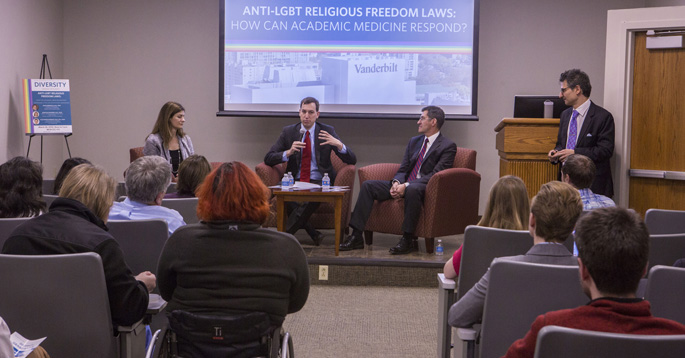
by Krystyna Barnard
Last week, the Department of Radiology and Radiological Sciences hosted a Diversity Grand Rounds panel addressing the impact of anti-LGBT religious freedom laws on academic medical centers, professional organizations and their members.
Co-sponsored by the Vanderbilt University Medical Center Program for LGBTI Health, the panel included speakers Jesse Ehrenfeld, MD, MPH, Martha Mainiero, MD, and Alexander Norbash, MD, MS. Radiology chair Reed Omary, MD, MS, moderated the panel titled “Anti-LGBT Religious Freedom Laws: How Can Academic Medicine Respond?”
The topic of the discussion was prompted by the Association of University Radiologists’ (AUR) decision to relocate its 2018 annual meeting from Tennessee to Florida as a result of California legislation AB 1887, which prohibits state-funded and state-sponsored travel to states with discriminatory LGBT laws. Tennessee is one of the eight states currently subject to the travel ban.
Omary said many of Vanderbilt’s radiologists are members of the AUR, and were looking forward to welcoming colleagues from institutions across the country to Nashville for the meeting.
“Having the meeting in Tennessee would have been an opportunity for our colleagues to experience all that Nashville and Vanderbilt have to offer,” he said.
Mainiero, who serves as president of the AUR, said that nearly 30 percent of AUR’s past meeting attendees reside in California and would have been unable to attend unless expenses were paid out-of-pocket. Norbash, chair of Radiology and associate vice chancellor for Diversity at the University of California San Diego, was among the UC system employees notified that they would not be reimbursed for activities, including medical conferences, taking place in one of the eight states outlined in the policy.
While it was a tough decision to relocate the meeting out of Tennessee, it was necessary because it served as an opportunity to raise the dialogue, said Mainiero. “It has been a learning, growing and eye-opening experience for a lot of radiologists who wouldn’t otherwise be paying attention to this topic.”
According to Ehrenfeld, professor of Anesthesiology and director of VUMC’s Program for LGBTI Health, conversations related to these issues are not new. AUR is among the more than 175 large professional medical organizations trying to navigate the challenges these policies pose for healthcare organizations and their members.
“When you think about what an organization fundamentally needs to do when we are supporting our members and advocating for health and our patients, there’s a conflict,” he said. “It puts organizations in a difficult position and may come across as punishing an already marginalized group to drive pressure for change.”
The panelists agreed that the media coverage around these policies has forced healthcare organizations to create dialogue on a necessary set of issues that need to be addressed.
“We can create a learning example out of this incident, learn how to communicate more effectively, and arrive at better solutions in a dynamic matter,” said Norbash.
When asked what physicians and healthcare organizations can do to solve these issues, Norbash suggested that physicians be verbal, engaged and proactive with state legislatures.
“This is an opportunity for common dialogue, engagement and problem solving,” he said. “Once our voices are united and elevated, we can change the system.”












